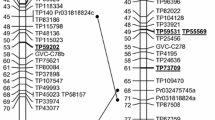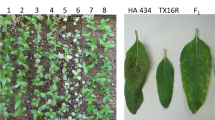Abstract
We report an early investigation into genomic organization and chromosomal transmission in switchgrass based on restriction fragment length polymorphism (RFLP) markers. The segregation of 224 single dose restriction fragments (SDRF) in 85 full-sib progeny of a cross between the genotypes Alamo (AP13) and Summer (VS16) was used to determine linkage associations in each parent. In the seed parent AP13, 11 cosegregation groups were identified by 45 SDRF markers with a cumulative recombination length of 412.4 cM. In the pollen parent VS16, 57 SDRF markers were assigned to 16 cosegregation groups covering a length of 466.5 cM. SDRF markers identified by the same probes and mapping to different cosegregation groups were used to combine the two maps and identify homology groups. Eight homology groups were identified among the nine haploid linkage groups expected in switchgrass. The high incidence of repulsion phase associations indicates that preferential pairing between homologous chromosomes is predominant in switchgrass. Based on marker distribution in the paternal map (VS16), we estimated the recombinational length of switchgrass genome to be 4,617 cM. In order to link 95% of the genome to a marker at a 15-cM distance, a minimum of 459 markers will be required. Using information from the ratio of repulsion to coupling linkages, we infer that switchgrass is an autotetraploid with a high degree of preferential pairing. The information presented in this study establishes a foundation for extending genetic mapping in this crop and constitutes a framework for basic and applied genetic studies.




Similar content being viewed by others

References
Al-Janabi SM, Honeycutt RJ, Sobral BWS (1994) Chromosome assortment in Saccharum. Theor Appl Genet 89:959–963
Arumuganthan K, Earle ED (1991) Nuclear DNA content of some important plant species. Plant Mol Biol Rep 9:208–218
Barnett FL, Carver RF (1967) Meiosis and pollen stainability in switchgrass, Panicum virgatumL. Crop Sci 7:301–304
Beckmann JS, Soller M (1983) Restriction fragment length polymorphisms in genetic improvement: methodologies, mapping and costs. Theor Appl Genet 67:35–43
Bishop DT, Cannings C, Skolnick M, Williamson JA (1983) The number of polymorphic DNA clones required to map the human genome. In: Wier BS (ed) Statistical analysis of DNA sequence data. Marcel Dekker, New York, pp 181–200
Bowers JH, Abbey C, Anderson S, Chang C, Draye X, Hope AH, Jessup R, Lemke C, Lennington J, Li Z, Lin Y-R, Liu S-C, Luo L, Marler BS, Ming R, Mitchell SE, Qiang D, Reschmann K, Schulze SR, Skinner DN, Wang Y-W, Kresovich S, Schertz KF, Paterson AH (2003) A high density recombination map of sequence-tagged sites for Sorghum, as a framework for comparative structural and evolutionary genomics of tropical grains and grasses. Genetics 165:367–386
Brouwer DJ, Osborn TC (1999) A molecular marker linkage map of tetraploid alfalfa (Medicago sativaL).Theor Appl Genet 99:1194–1200
Brown WV (1948) A cytological study in the Gramineae. Am J Bot 35:382–395
Brunken JN, Estes JR (1975) Cytological and morphological variation in Panicum virgatum L. Southwest Nat 19:379–385
Burton GW (1942) A cytological study of some species in the tribe Paniceae. Am J Bot 29:355–359
Causse M, Fulton TM, Cho YG, Ahn SN, Chunwongse J, Wu K, Xiao J, Yu Z, Ronald PC, Harrington SB, Second GA, McCouch SR, Tanksley SD (1994) Saturated molecular map of the rice genome based on an interspecific backcross population. Genetics 138:1251–274
Chakravarti A, Lasher LK, Reefer JE (1991) A maximum likelihood method for estimating genome length using genetic linkage data. Genetics 128:175–182
Church GL (1929) Meiotic phenomena in certain Gramineae. II Paniceae and Andropogoneae. Bot Gaz 88:63–84
Church GL (1940) Cytotaxonomic studies in the Gramineae Spartina, Andropogon, and Panicum. Am J Bot 27:263–271
Csanadi G, Vollmann J, Stift G, Lelley T (2001) Seed quality QTLs identified in a molecular map of early maturing soybean. Theor Appl Genet 103:912–919
Da Silva JAG, Sorrells ME (1996) Linkage analysis in polyploids using molecular markers. In: Jauhar PP (ed) Methods of genome analysis in plants. CRC Press, Boca Raton, pp 211–228
Da Silva JAG, Sorrells ME, Burnquist WL, Tanksley SD (1993) RFLP linkage map and genome analysis of Saccharum spontaneum. Genome 36:182–791
Doganlar S, Tanksley SD, Mutschler MA (2000) Identification and molecular mapping of loci controlling fruit ripening time in tomato. Theor Appl Genet 100:249–255
Feinberg AP, Vogelstein B (1983) A technique for radiolabelling DNA restriction fragments to a high specific activity. Anal Biochem 132:6–13
Grivet L, D’Hont A, Roques D, Feldmann P, Lanaud C, Glaszmann JC (1996) RFLP mapping in cultivated sugarcane (Saccharum spp.): genome organization in a highly polyploid and aneuploid interspecific hybrid. Genetics 142:987–1000
Hitchcock AS (1971) Manual of grasses of the United States, vol II. Dover Publ, New York
Hopkins AA, Taliaferro CM, Murphy CD, Christian D (1996) Chromosome number and nuclear DNA content of several switchgrass populations. Crop Sci 36:1192–1195
Huang S, Su X, Haselkorn R, Gornicki P (2003) Evolution of switchgrass (Panicum virgatum L.) based on sequences of the nuclear gene encoding plastid acetyl-CoA carboxylase. Plant Sci 164:43–49
Hulbert S, Ilott T, Legg EJ, Lincoln S, Lander E, Michelmore R (1988) Genetic analysis of the fungus Bremia lactucae, using restriction length polymorphism. Genetics 120:947–958
Hultquist SJ, Vogel KP, Lee DJ, Arumuganathan K, Kaeppler S (1996) Chloroplast DNA and nuclear DNA content variations among cultivars of switchgrass, Panicum virgatum L. Crop Sci 36:1049–1052
Jiang C, Wright RJ, Woo SS, Del Monte TA, Paterson AH (2000) QTL analysis of leaf morphology in tetraploid Gossypium (cotton). Theor Appl Genet 100:409–418
Kandemir N, Kudrna DA, Ullrich SE, Kleinhofs A (2000) Molecular marker assisted genetic analysis of head shattering in six-rowed barley. Theor Appl Genet 101:203–210
Kebede H, Subudhi PK, Rosenow DT, Nguyen HT (2001) Quantitative trait loci influencing drought tolerance in grain sorghum (Sorghum bicolor L Moench). Theor Appl Genet 103:266–276
Keller B, Feuillet C (2000) Colinearity and gene density in grass genomes. Trends Plant Sci 5:246–251
King IP, Koebner RMD, Reader SM, Miller TE (1991) Induction in the male fertility gene of the preferentially transmitted Aegilops sharoneneis chromosome 4S and its application for hybrid wheat production. Euphytica 54:33–39
Kosambi DD (1944) The estimation of map distances from recombination values. Ann Eugen 12:172–175
Kowalski SP, Lan TH, Feldman KA, Paterson AH (1994) Comparative mapping of Arabidopsis thaliana and Brassica oleracea chromosomes reveals islands of conserved organization. Genetics 138:499–510
Krieger A, Cervantes JC, Burg K, Mwanga RO, Zhang DP (2000) A genetic linkage of sweet potato [Ipomoea batatas (L) Lam] based on AFLP markers. CIP (International Potato Center) Program Report 1999–2000, Lima, Peru, pp 303–313
Lagercrantz U, Putterill J, Coupland G, Lydiate D (1996) Comparative mapping in Arabidopsis and Brassica, congruence of genes controlling flowering time. Plant J 9:13–20
Lan TH, Paterson AH (2000) Comparative mapping of quantitative trait loci sculpting the curd of Brassica oleracea. Genetics 155:1927–1954
Lander ES, Green P (1987) Construction of multilocus genetic linkage maps in humans. Proc Natl Acad Sci USA 84:2363–2367
Lander ES, Green P, Abrahamson J, Barlow A, Daly MJ, Lincoln SE, Newburg L (1987) mapmaker: an interactive computer package for constructing primary genetic linkage maps of experimental and natural populations. Genomics 1:174–181
Lange K, Boehnke M (1982) How many polymorphic marker genes will it take to span the human genome?. Am J Hum Genet 34:842–845
Li X, van Eck HJ, Rouppe van der Voort JNAM, Huigen D-J, Stam P, Jacobsen E (1998) Autotetraploids and genetic mapping using common AFLP markers: the R2 allele conferring resistance to Phytophthora infestans mapped on potato chromosome 4. Theor Appl Genet 96:1121–1128
Liu CJ, Devos KM, Witcombe JR, Pittaway TS, Gale MD (1996) The effect of genome and sex on recombination rates in Pennisetum species. Theor Appl Genet 93:902–908
Lu H, Romero-Severson J, Bernardo R (2002) Chromosomal regions associated with segregation distortion in maize. Theor Appl Genet 105:622–628
Luo S, He P, Zheng X, Zhou P (2002) Inheritance of RAPD markers in an interspecific F1 hybrid of grape between Vitis quinquangularis and V. vinifera. Sci Hortic 93:19–28
Martinez-Reyna JM, Vogel KP (2002) Incompatibility systems in switchgrass. Crop Sci 42:1800–1805
Martinez-Reyna JM, Vogel KP, Caha C, Lee DJ (2001) Meiotic stability, chloroplast DNA polymorphisms, and morphological traits of Upland Lowland Switchgrass reciprocal hybrids. Crop Sci 41:1579–1583
Mather K (1935) Reductional and equational separation of the chromosomes in bivalents and multivalents. J Genet 30:53–78
Mather K (1957) The measurement of linkage in heredity. Methuen and Co., London
Ming R, Liu S-C, Lin Y-R, da Silva JAG, Wilson W, Braga D, van Deynze A, Weslaff TF (1998) Detailed alignment of Saccharum and Sorghum chromosomes: comparative organization of closely related diploid and polyploidy genomes. Genetics 150:1663–1682
Missaoui AM (2003) Molecular investigation of the genetic variation and polymorphism in switchgrass (Panicum virgatum L) cultivars and development of a DNA marker for the classification of switchgrass germplasm. PhD thesis, The University of Georgia, Athens, Ga.
Murray MG, Thompson WF (1982) Rapid isolation of high molecular weight plant DNA. Nucleic Acids Res 8:4321–4325
Nielson EL (1944) Analysis of variation in Panicum virgatum. J Agric Res 69:327–353
Paterson AH, Feldmann KA, Wendel JF (1996) Toward a unified genetic map of higher plants, transcending the monocot-dicot divergence of outstanding interest. Nat Genet 14:380–383
Pichersky E (1990) Nomad DNA—a model and duplication of DNA sequences in plants genomes. Plant Mol Biol 15:437–448
Porter CL (1966) An analysis of variation between upland and lowland switchgrass Panicum virgatum L in central Oklahoma. Ecology 47:980–992
Qu L, Hancock JF (2001) Detecting and mapping repulsion-phase linkage in polyploids with polysomic inheritance. Theor Appl Genet 103:136–143
Ribaut J-M, Hoisington D (1998) Marker-assisted selection: new tools and strategies. Trends Plant Sci 3:236–239
Sanderson MA, Reed RL, McLaughlin SB, Wullschleger SD, Conger BV, Parrish DJ, Wolf DD, Taliaferro C, Hopkins AA, Osumpaugh WR, Hussey MA, Read JC, Tischler CR (1996) Switchgrass as a sustainable bioenergy source. Bioresour Technol 56:83–93
Sorrells ME (1992) Development and application of RFLPs in polyploids. Crop Sci 32:1086–1091
Southern EM (1975) Detection of specific sequences among DNA fragments separated by gel electrophoresis. J Mol Biol 98:503–517
Talbert LE, Timothy DH, Burns JC, Rawlings JO, Moll RH (1983) Estimates of genetic parameters in Switchgrass. Crop Sci 23:725–728
Taylor DR, Ingvarsson PK (2003) Common features of segregation distortion in plants and animals. Genetica 117:27–35
Van Deynze AE, Sorrells ME, Park WD, Ayres NM, Fu H, Cartinhour SW, Paul E, McCouch SR (1998) Anchor probes for comparative mapping of grass genera. Theor Appl Genet 97:356–369
Wang D, Karle R, Brettin TS, Iezzoni AF (1998) Genetic linkage map in sour cherry using RFLP markers. Theor Appl Genet 97:1217–1224
Warmke HE (1954) Apomixis in Panicum maximum. Am J Bot 41:5–11
Whitkus R, Doebley J, Lee M (1992) Comparative genome mapping of sorghum and maize. Genetics 132:119–130
Wu KK, Burnquist W, Sorrells ME, Tew TL, Moore PH, Tanksley SD (1992) The detection and estimation of linkage in polyploids using single-dosage restriction fragments. Theor Appl Genet 83:294–300
Wu R, Gallo-Meagher M, Littell RC, Zeng Z-B (2001) A general polyploid model for analyzing gene segregation in outcrossing tetraploid species. Genetics 159:869–882
Wu R, Ma C-X, Casella G (2002) A bivalent polyploid model for linkage analysis in outcrossing tetraploids. Theor Popul Biol 62:129–151
Yadav RS, Hash CT, Bidinger FR, Cavan GP, Howarth CJ (2002) Quantitative trait loci associated with traits determining grain and stover yield in pearl millet under terminal drought-stress conditions. Theor Appl Genet 104:67–83
Yu KF, Pauls KP (1993) Segregation of random amplified polymorphic DNA markers and strategies for molecular mapping in tetraploid alfalfa. Genome 36:844–851
Zuloaga F, Monroe O, Dubcovsky J (1989) Exomorphological, anatomical, and cytological studies in Panicum validum (Poaceae: Panicoideae: Panacea): its systematic position within the genus. Syst Bot 14:220–230
Acknowledgments
This research was supported by the U.S. Department of Energy, Environmental Sciences Division, Oak Ridge National Lab, via UT Battelle subcontract (19X-SV810C).
Author information
Authors and Affiliations
Corresponding author
Additional information
Communicated by H. H. Geiger
Electronic Supplementary Material
Rights and permissions
About this article
Cite this article
Missaoui, A.M., Paterson, A.H. & Bouton, J.H. Investigation of genomic organization in switchgrass (Panicum virgatum L.) using DNA markers. Theor Appl Genet 110, 1372–1383 (2005). https://doi.org/10.1007/s00122-005-1935-6
Received:
Accepted:
Published:
Issue Date:
DOI: https://doi.org/10.1007/s00122-005-1935-6



